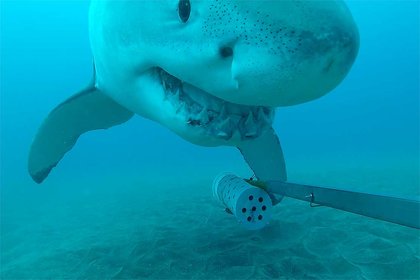
Great white shark inspecting video set.
Massey scientists captured some astonishing footage of a great white shark on a recent research expedition to the Southwest Pacific.
The 3 to 4-metre-long male shark was caught on film in Rangitāhua (Kermadec Islands), which lie 1000 km northeast of the North Island of New Zealand. It was filmed using a Baited Remote Underwater Video set (BRUV), which is an arrangement of two video cameras and a canister of bait attached to a steel frame, which is deployed on the sea floor for 60-90 minutes as a means of surveying marine life.
Massey scientist Dr Adam Smith led the BRUV project, along with postgraduate student Odette Howarth, marine technician Emma Betty, and shark scientist Clinton Duffy.
Dr Smith says the encounter left the team “buzzing”.
“When the gear is on the seabed, we don’t have a live feed so we have no idea what we’re going to see when we review the footage at the end of the day. The most common sharks were grey and whitetip reef sharks, but we also encountered tiger sharks, hammerheads, and some very obnoxious octopus.
Getting the great white at the end of the trip was definitely a highlight though, especially considering they’ve only been recorded at the Kermadecs a few times before. It’s likely that some great whites stopover while migrating between NZ and the tropics, like humpback whales do.
“The shark calmly circled the bait for a few minutes before approaching the gear and giving it a few ‘curiosity bites’. It then effortlessly picked up the entire BRUV set, swam with it up to the surface, and then dropped it back to the sea floor. It did this a total of three times, before losing interest and swimming off.”
While Dr Smith and the team were excited by what they had found, they were discouraged by low numbers of sharks at some locations they visited. “We were happy to see large numbers of sharks on some submerged banks in the tropics, and New Zealand’s Kermadec Islands, but there were surprisingly few in many other locations, probably due to overfishing.”
“New Zealand is very lucky to have two global hotspots for great whites in the Chatham Islands and Stewart Island,” says Dr Smith of Massey's Institute of Natural and Mathematical Sciences.
The project aims to quantify patterns in fish biodiversity across the Southwest Pacific, by reference to particular habitats and environmental conditions, and human impacts. They also hope to gain a better understanding New Zealand’s marine ecosystems in a regional context, and plan on doing similar surveys in the Hauraki Gulf region over the coming months.
The footage from the Pacific will also contribute to the Global FinPrint project, which is undertaking a huge number of BRUV surveys in coastal tropical regions across the world to fill critical information gaps about the diminishing number of sharks and rays.
Now that the footage is gathered, the team will get work on the data.
“The hard work is just beginning. We will spend hours turning the footage into data that can then be analysed to describe patterns in biogeography, behaviour, and species-habitat associations.
“If you are interested in this kind of thing and you have a relevant background, then please get in touch. This sort of work provides great opportunities for postgraduate students,” Dr Smith says.
They also plan to conduct further shark surveys over the summer in the Hauraki Gulf, where they may encounter great whites, but will most likely find other species.
The BRUV project was one of several biodiversity projects undertaken as part of the Auckland Museum-led research expedition on board the 40-m research vessel, RV Braveheart. The six-week expedition left New Caledonia in July, venturing to southern Fiji, Tonga, the Kermadecs, and finished up in Tauranga in September. It involved participants from Te Papa, Australian Museum, Conservation International, and the Sir Peter Blake Trust.
For more information please contact:
Ryan Willoughby
+64 21 740 414
R.J.Willoughby@massey.ac.nz